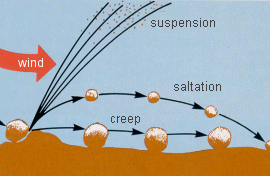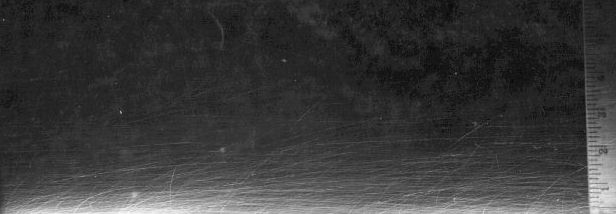.gif)
Saltation (geology)
Encyclopedia

Geology
Geology is the science comprising the study of solid Earth, the rocks of which it is composed, and the processes by which it evolves. Geology gives insight into the history of the Earth, as it provides the primary evidence for plate tectonics, the evolutionary history of life, and past climates...
, saltation (from Latin
Latin
Latin is an Italic language originally spoken in Latium and Ancient Rome. It, along with most European languages, is a descendant of the ancient Proto-Indo-European language. Although it is considered a dead language, a number of scholars and members of the Christian clergy speak it fluently, and...
, saltus, "leap") is a specific type of particle
Particle
A particle is, generally, a small localized object to which can be ascribed physical properties. It may also refer to:In chemistry:* Colloidal particle, part of a one-phase system of two or more components where the particles aren't individually visible.In physics:* Subatomic particle, which may be...
transport by fluids such as wind
Wind
Wind is the flow of gases on a large scale. On Earth, wind consists of the bulk movement of air. In outer space, solar wind is the movement of gases or charged particles from the sun through space, while planetary wind is the outgassing of light chemical elements from a planet's atmosphere into space...
or water
Water
Water is a chemical substance with the chemical formula H2O. A water molecule contains one oxygen and two hydrogen atoms connected by covalent bonds. Water is a liquid at ambient conditions, but it often co-exists on Earth with its solid state, ice, and gaseous state . Water also exists in a...
. It occurs when loose material is removed from a bed and carried by the fluid, before being transported back to the surface. Examples include pebble
Pebble
A pebble is a clast of rock with a particle size of 4 to 64 millimetres based on the Krumbein phi scale of sedimentology. Pebbles are generally considered to be larger than granules and smaller than cobbles . A rock made predominantly of pebbles is termed a conglomerate...
transport by rivers, sand
Sand
Sand is a naturally occurring granular material composed of finely divided rock and mineral particles.The composition of sand is highly variable, depending on the local rock sources and conditions, but the most common constituent of sand in inland continental settings and non-tropical coastal...
drift over desert surfaces, soil
Soil
Soil is a natural body consisting of layers of mineral constituents of variable thicknesses, which differ from the parent materials in their morphological, physical, chemical, and mineralogical characteristics...
blowing over fields, or even snow
Snow
Snow is a form of precipitation within the Earth's atmosphere in the form of crystalline water ice, consisting of a multitude of snowflakes that fall from clouds. Since snow is composed of small ice particles, it is a granular material. It has an open and therefore soft structure, unless packed by...
drift over smooth surfaces such as those in the Arctic
Arctic
The Arctic is a region located at the northern-most part of the Earth. The Arctic consists of the Arctic Ocean and parts of Canada, Russia, Greenland, the United States, Norway, Sweden, Finland, and Iceland. The Arctic region consists of a vast, ice-covered ocean, surrounded by treeless permafrost...
or Canadian Prairies
Canadian Prairies
The Canadian Prairies is a region of Canada, specifically in western Canada, which may correspond to several different definitions, natural or political. Notably, the Prairie provinces or simply the Prairies comprise the provinces of Alberta, Saskatchewan, and Manitoba, as they are largely covered...
.
At low fluid velocities, loose material rolls downstream, staying in contact with the surface. This is called creep or reptation. Here the forces exerted by the fluid on the particle are only enough to roll the particle around the point of contact with the surface.
At higher speeds, the lift and moment exerted by the fluid on the particle is enough to pull it away from the surface and into the flow. Initially the particle moves quite rapidly compared to the flow and so has high lift, moving it away from the surface. As the particle moves into the faster flow away from the bed, the velocity difference between particle and flow decreases, and so lift decreases. When the particle weight is greater than the lift force, the particle sinks back towards the surface. During its descent, the particle keeps some of the speed it picked up in the faster moving flow, and so returns to the surface at higher speed than the fluid near the surface.
Depending on the surface, more loose material could be dislodged by the impacting particle, the particle might disintegrate on impact, or the particle could continue bouncing downstream. In rivers, this process repeats continually, gradually eroding away the river bed, but also transporting-in fresh material from upstream.
Suspension generally affects small particles ('small' means 100 micrometres or less for particles in air). These particles experience lift forces which are similar in magnitude to the weight of the particle. These smaller particles are carried by the fluid in suspension, and convected downstream. Particles are carried until the fluid decelerates. When the weight is greater than the lift, the particles settle out.

A recent study finds that saltating sand particles induces a static electric field by friction. Saltating sand acquires a negative charge relative to the ground which in turn loosens more sand particles which then begin saltating. This process has been found to double the number of particles predicted by previous theory. This is significant in meteorology because it is primarily the saltation of sand particles which dislodges smaller dust particles into the atmosphere. Dust particles and other aerosols such as soot affect the amount of sunlight received by the atmosphere and earth, and are nuclei for condensation of the water vapour.
See also
- Aeolian landformAeolian landformAeolian landforms are features of the Earth's surface produced by either the erosive or constructive action of the wind. This process is not unique to earth, and it has been observed and studied on other planets, including Mars.-Terminology:...
- Aeolian processes
- Bagnold formulaBagnold FormulaThe Bagnold formula, named after Ralph Alger Bagnold, relates the amount of sand moved by the wind to wind speed by saltation. It states that the mass transport of sand is proportional to the third power of the friction velocity...
- Saltation (biology)Saltation (biology)In biology, ""saltation"" is a sudden change from one generation to the next, that is large, or very large, in comparison with the usual variation of an organism...
- Saltatory conductionSaltatory conductionSaltatory conduction is the propagation of action potentials along myelinated axons from one node of Ranvier to the next node, increasing the conduction velocity of action potentials without needing to increase the diameter of an axon.-Mechanism:Because the cytoplasm of the axon is electrically...
- The Physics of Blown Sand and Desert Dunes

